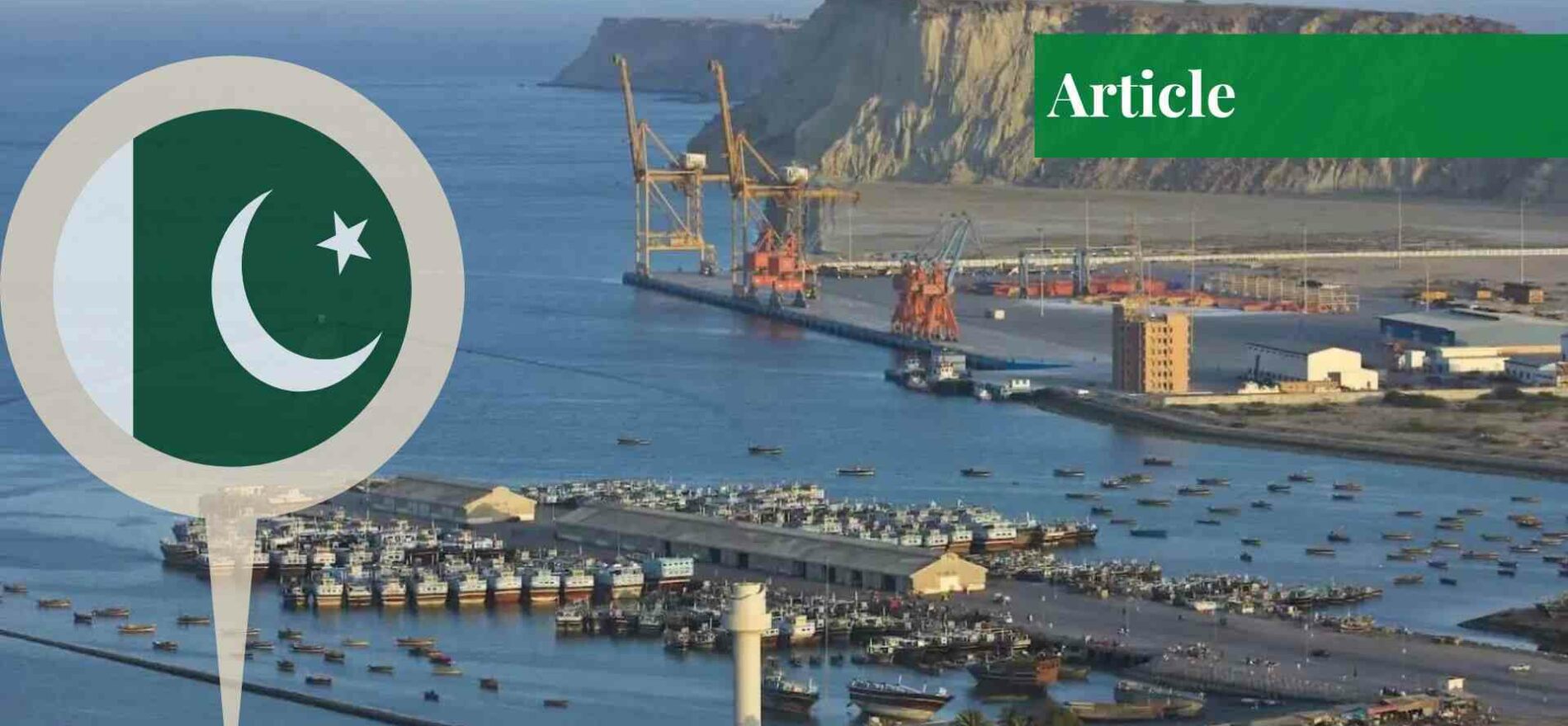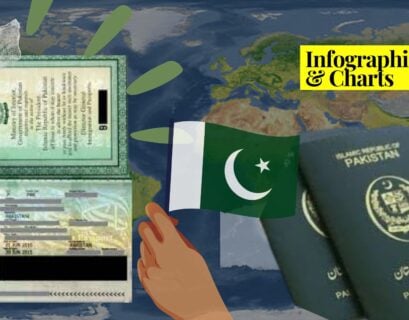Ms Fatimah Naeem is pursuing her Bachelor's in Peace and Conflict Studies from National Defence University Islamabad.
Since ancient times, sea routes have played a significant role in establishing connections between continents and shaping the world into a global village. The need to provide docking and other facilities to massive shipping vessels increased day by day. That is where “seaports” came in. These ports are situated close to coastal lines in hopes of fostering connectivity while assisting trade and commerce activities.
To proceed with the discourse, one should be able to distinguish between “seaports” and “harbors.”
A seaport is considered to be a state’s commercial water facility which constitutes warehouses for the wear and tear of the vessels, along with docks, cranes, and infrastructure for handling cargo. Providing facilities for the movement of goods between local and global markets, seaports encompass the functions of a maritime hub. A harbor, on the other hand, offers a mooring place for ships and other waterborne vessels to safely anchor themselves.
Pakistan’s Seaports:
Pakistan’s geographical location provides the country with economic as well as military leverage. With a 1064-kilometer-long coastline, Pakistan has utilized its key maritime hubs for negotiating strategic alliances with China and catalyzing commerce with landlocked countries in Central Asia.
A comprehensive analysis of the seven major seaports of Pakistan is given below:
Karachi Port and Harbor
Numerous headlines across the world read Karachi as “the economic hub of Pakistan” and the “City of Lights” but many fail to understand the reasoning behind it. “Karachi Port and Harbor” is one of the most ancient seaports in the entirety of South Asia, predating Pakistan’s existence. To be more precise, a nebulous idea of its foundation can be traced back to the time of the Mughal Empire in 1557 when a preserved pamphlet, from that era, described the Karachi Port as a resting place for Turkish travelers and merchants. During British colonial rule, the port was utilized as a strategic seaborne route.
Peeking into trade, the port handles nearly 60% of the country’s national imports and exports. Boasting an annual 65.62 million tons of cargo and 1.56 million TEUs (Twenty-foot Equivalent Units), Karachi Port anchors considerable vitality.
Sitting on 32 km of wharves and docks, the anchorage depth of the seaport is 16 meters. In addition, 41 berths and 8 wharves are utilized by incoming and outgoing commercial vessels.
Accessing its harbor abilities, the Karachi Port offers space for naval and commercial shipbuilding and repair. The harbor also provides facilities such as dry docks, steel handling plants, and construction complexes. Another important factor that contributes to the ports’ significance is its proximity to the Strait of Hormuz and the Suez Canal.
Since its inception, Pakistan has been working towards alleviating the burden and congestion of the Karachi Port which has sown seeds for the building of other seaports along the commercially advantageous coastline.
The Pakistan Seaport of Gwadar
Situated in the nexus of Balochistan, the Gwadar Port is a recent development of the state to enhance its commercial stature while bringing about economic and social prosperity to the compromised region. The port spans a total area of 2,292 acres, and it is known as the deepest seaport in the world.

The Gwadar Port of Pakistan became operational in 2016 to boost the economic alliance between Pakistan and China through CPEC, a commercial and trade project between the two.
It opens into the Arabian Sea under the administration of the Gwadar Port Authority (GPA). The operational and executive control over the entirety of the Gwadar Port has been handed over to the China Overseas Port Holding Company (COPHC) and has been leased to China till the year 2059.
Linking the port to the Maritime Silk Road (MSR) and Belt and Road projects, Gwadar Port has also boosted some enticing initiatives such as Pak-Afghan trade and CPEC.
The Gwadar Port is significantly closer to the Chabahar Port of Iran with viable access to the Strait of Hormuz and Gulf of Oman. This geographic positioning has assisted in factorizing multiple expansionary activities for the seaport.
According to reports from ISSI (Institute of Strategic Studies Islamabad), the current cargo capacity of the port, as of 2023, is 8.5 million tons while the current container capacity can be rounded off to 30 million TEUs. The expansionary projects have proposed the management of cargo capacity worth 400 million tons by 2045.
Moreover, the port is characterized by a floating liquefied natural gas facility, the Gwadar Special Economic Zone, and a dedicated facility to promote CPEC interests. Future propositions include linking the port to the Khunjerab railway to establish a commuting route with industrial hubs that are situated within the vicinity.
The Pakistan Seaport of Muhammad Bin Qasim
Named after the great Muslim emperor Muhammad Bin Qasim, the port was established in the year 1890, in Karachi.
Crowned the second busiest port in Pakistan, it roughly handles 35% of the state’s total maritime trade with impressive statistics leading up to 1,500 port calls, a container volume of 700,000 TEUs, and an annual cargo tonnage of 16.6 million tons.
The artificial port has been carrying out operational duties since the 1980s and harbors 50 sq km of the area while also being conveniently close to the Korangi Industrial Area, Mehran Town, Lucknow Society, and Allah Wala Town. It supports local as well as international shipping lines.
Moreover, it houses around 273 industrial units and is situated close to the customs office, making the import/export process easier.
To bring administrative ease, the harbor is categorized into three main zones:
- Northwestern Industrial Zone (2,920 acres)
- Southwestern Industrial Zone (1,000 acres)
- Eastern Industrial Zone (8,300 acres)
State-of-the-art facilities such as additional liquid cargo terminals, container terminals, oil terminals, and a steel jetty are all predicted initiatives set in motion by the Port Qasim Authority (PQA).
Another commendable initiative is the collaboration between “Pakistan Customs” and the “US Customs and Border Protection Forces” which is focusing on an integrated cargo-contained control facility that will scan shipments bound for the US at Port Qasim. Along with revamping maritime trade security, it also plays the effective role of risk-reduction for inbound goods.
The Pakistan Seaport of Keti Bandar
Pakistan seaport of Keti Bandar is the state’s oldest port and has been offering opportunities to local prospects while playing a conducive role in enhancing the fishing industry of the country. Only a four-hour drive away from Karachi, the port is located in the Thatta district and has been economically supporting the native population.
Being an extension of the ancient port of Debal near Manora island, the current port is situated adjacent to the Indus River.
The port is expected to develop further as a part of CPEC. Being closely linked to the national highway (N-10), it offers accessibility for better import/export opportunities.
Furthermore, it is positioned close to Gharo and Mirpur Sakro – two rapidly developing towns in the Sindh province. The surrounding settlements are mostly dependent on the port and its fishing activities to bring about socio-economic sustainability. The accumulated hundreds of kilograms of fish are sold at the quayside markets where Arabian Sea produce is preferred.
The Pakistan Seaport of Ormara
Located between the ports of Karachi and Gwadar, the Pakistan seaport of Ormara stretches along the Makran coast harboring commercial as well as naval significance for the country. Functioning since the era of Alexander the Great, the port has provided substantial accessibility and control to the Indus region.
The port is an important aspect of Pakistan’s fishing industry and has been consistently operational in shipping fresh produce to the larger harbors for repackaging and subsequent export. Similar to the Keti Bandar Port, Ormara Port has successfully drawn a linkage to N-10 which has contributed to developing the port and bringing in much-needed facilities.
Additionally, Ormara also houses Pakistan’s Jinnah naval base. Holding the title of the second-largest naval base in the country, its galvanization was undertaken on behalf of the Ministry of Defence by Belgium and Turkey. The construction of the naval base has brought about significant prosperity in achieving the economic agenda.
The proximate cadet college has also helped in boosting finances at the port. Lastly, the government of Pakistan has also introduced various schemes to redeem the lost spark of Ormara’s prosperity and to invest in its revitalization, helping it achieve the status of a thriving strategic hub by 2030.
The Pakistan Seaport of Pasni
Another notable entity along the Makran coastline is the Pasni Port. It is relatively smaller than the others but similar when it comes to efficient trade operations. The functional capacity of the port and its jurisdiction fall under both the Balochistan Port Authority and Pakistan’s maritime affairs Federal Secretary.
Due to the lack of arable land, the locality depends heavily on the port-to-ship supplements. Impressively, the port harbors’ up-to-date facilities combat economic and sustenance shortcomings while providing an adequate fishing harbor as well.
The regulatory authority for the matters of fishing and harbor activities falls under the Balochistan Sea Fisheries Act of 1971 and is intended to protect marine life and the livelihood of the locals.
Moreover, a considerable amount of the exports are designated for Turbat and Karachi. The facilities are expected to meet the requirements set for export to EU states, repackaging the produce once again before the final departure. Accrediting the Pasni naval base, the port is established conveniently close to major roadways and air bases that link the seaport with the Pasni airport as well as N-10.
The Pakistan Seaport of Jiwani
As one moves 60 km west from the Gwadar Port, there rests the Pakistan seaport of Jiwani. The utilization of the port for both naval and commercial purposes has been carried out since WWII.
Located close to the Gulf of Oman, the Strait of Hormuz, the Persian Gulf, and Iran’s Chabahar port, Jiwani port holds significant strategic importance. More importantly, China has taken an interest in establishing an off-shore base within the Jiwani Port similar to the way it has done so in Gwadar. This expansionary project falls under the strategic and economic interests of both Pakistan and China.
Furthermore, the vamping up of the fishing facilities and setting up of off-shore drilling units has been the focal point of future development projects to attract foreign investment. The locals of Jiwani are majorly dependent on the sale and export of fish products to the urban centers of Pakistan and abroad as well.
Why Are Pakistan’s Seaports Not Utilized to Their Full Potential?
Pakistan’s fortunate geographic position along the cusp of the Arabian Sea has invited a heightened potential for trade. Unfortunately, the three major ports, namely, Karachi Port, Gwadar Port, and Bin Qasim Port lack the infrastructure and capacity to manage the sea traffic threshold that is being demanded in the contemporary world. The poor operational capabilities are credited to political, security, technical, and socioeconomic concerns. Logistics Performance Indicators (LPI) report that in comparison to Bangladesh and Sri Lanka, Pakistan’s seaport industries have been going through a downward spiral.
The constantly changing tides of Pakistan’s governance intimidate potential investors, driving the country’s maritime prospects to endangerment. The political polarity has also deviated responsible officials from their duties despite being federally and provincially appointed.
Bringing in a new wave of security dilemmas, the development of Gwadar Port, specifically, has been targeted on multiple occasions. Regarded as an unfair disposition towards the native Baloch, attempts to jeopardize the project, by both internal and external actors, have been constant since its inception.
As for the technical shortcomings, one may assume them to be innumerable, due to a lack of visionary approach. Intermodal and multimodal transportation schemes are known to be effective in combating the persisting inadequate value chain, but poor port structure and related infrastructural issues have adversely affected the promising potential of Pakistan’s seaports.
Last but not least, socioeconomic concerns have been ignored the most. The local populations residing within the vicinity of the seaports face deprivation in terms of inclusivity within the policy-making. Although the development of seaports is tied to the nexus of human welfare, the lack thereof has led to tensions brewing amongst the locals.
A Possibility to Turn Harsh Tides?
Pakistan offers trade connectivity to countries like China, Afghanistan, and numerous Central Asian states. Utilizing this prospect, the government should negotiate deals and investments in an attempt to alleviate Pakistan’s socioeconomic burden. The port of Gwadar holds a unique potential to be operated as a trans-shipment hub due to its location near the Strait of Hormuz. Moreover, constructing more berths and building an advanced mechanized setup for cargo-customs clearance would also prove to be a time-efficient and effective approach for further port development.
Decreasing the polarity and increasing the inclusivity among the responsible authorities and local population through capacity-building and policy-making activities would also aid in reducing social ignorance surrounding the deprived localities near the seaports.
Conclusion
Pakistan has many opportunities to exercise its maritime potential but unfortunately, has been suffering from a lack of progress. With soaring inflation and deteriorating political conditions, the country’s trade and commerce have been suffering in the highly competitive global import/export industry. Navigating through high tides and still seas, Pakistan’s numerous ports have proved to be a commendable asset that can further thrive and flourish if the concerned authorities pay their due attention to its development.
If you want to submit your articles, research papers, and book reviews, please check the Submissions page.
The views and opinions expressed in this article/paper are the author’s own and do not necessarily reflect the editorial position of Paradigm Shift.



















